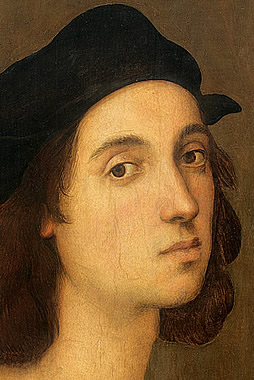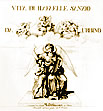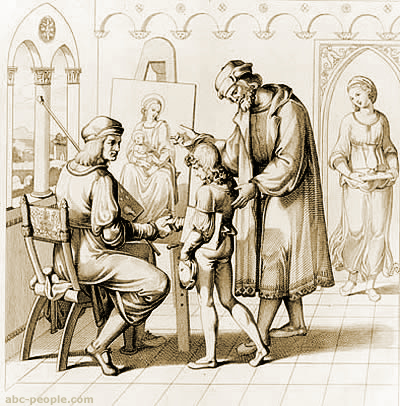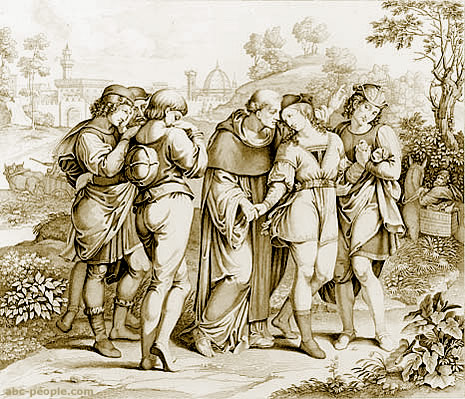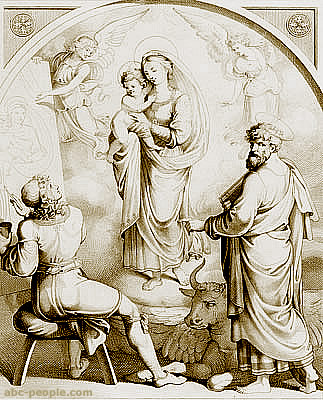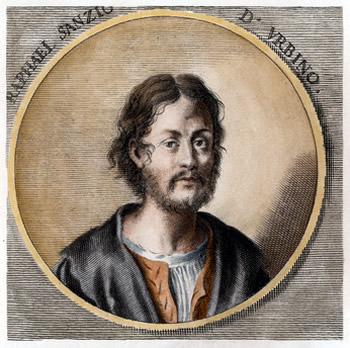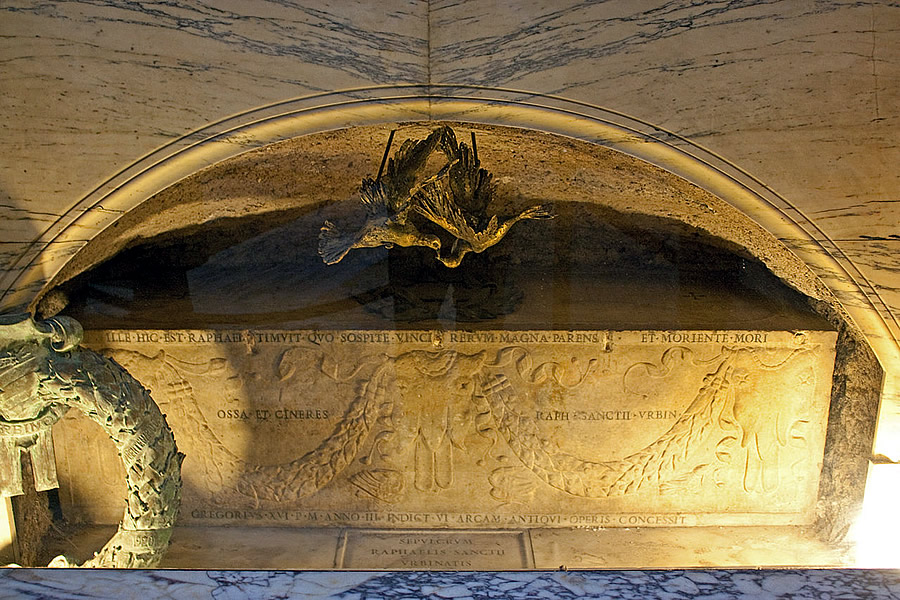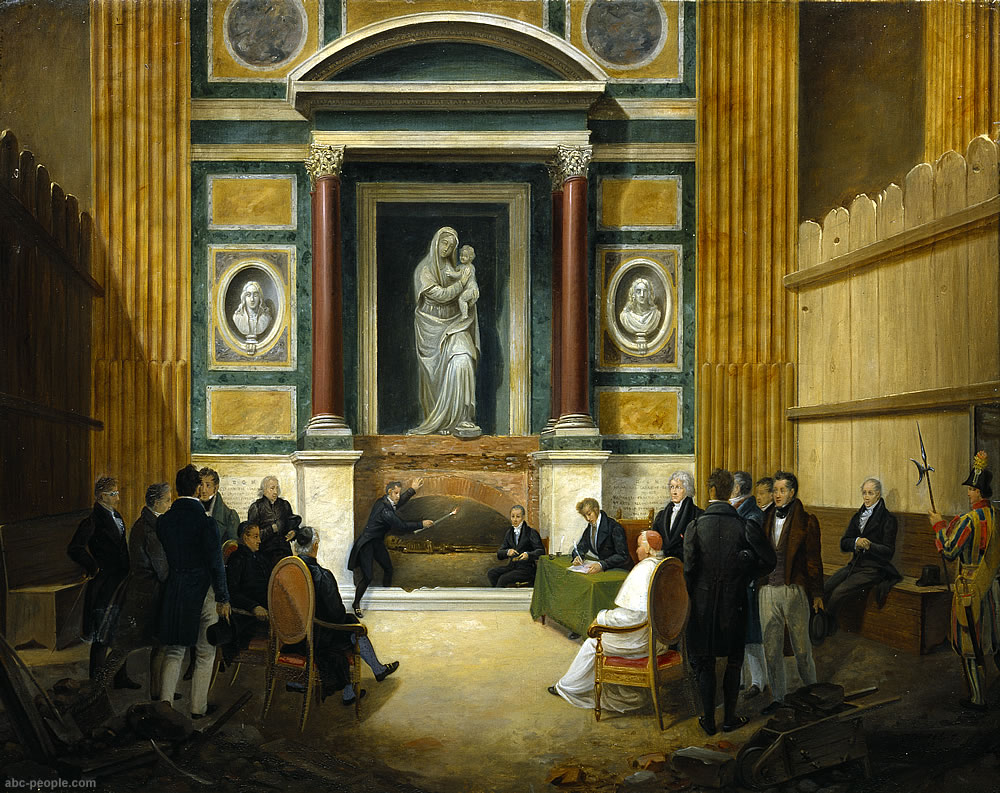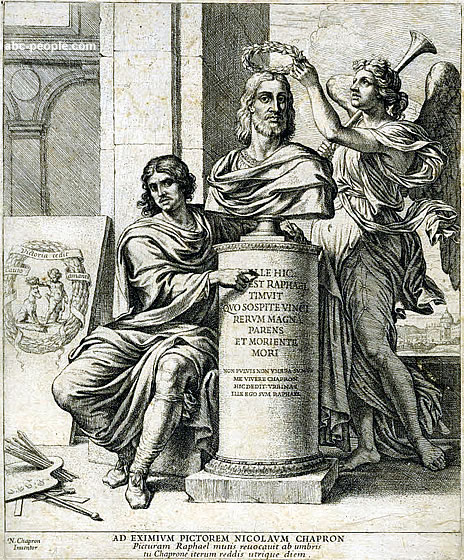| Raphael's
biography |
|
Life
stories of Raphael |
|||
|
|||||
|
Early
years at Urbino |
Apprenticeship
at Perugia |
Move
to Florence |
|||
Last
years in Rome |
Raphael's
works in Rome |
Death
and Funeral of Raphael |
|||
Perpetuate
the memory of Raphael |
Where
is Raphael buried? |
||||
| Raphael
Sanzio
"When
he died, the heavens wanted to give one of the signs they gave when
Jesus Christ expired... Here, people are talking about nothing but
the death of this exceptional man, who has completed his first life
at the young age of 37. His second life - that of his fame, which
is subject neither to time nor death - will endure for all eternity..." |
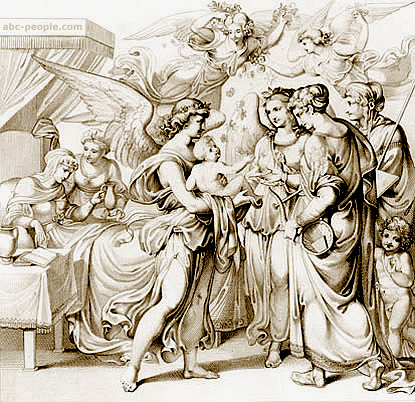 Franz and Christian von Hausen Riepe (Riepenhausen) Raphael's birth on Good Friday in 1483 Engraving, 1816 |
One of the triumvirate of High Renaissance art (along with Michelangelo and Leonardo da Vinci), Raffaello Sanzio (or Santi), known as Raphael, was born in Urbino, Marche, Italy, on April 6, 1483. He was born on Holy Friday at three hours of the night. There are doubts regarding his exact date of birth. It’s either April 6 or March 28, 1483. "Raphael's protective angel holds the newborn in his arms and gives him the Muses. Poetry, sound art and Mahlerei, accompanied by a small love God, is the smiling boy move towards and seem to greet him. Genii float in height and sprinkle him flowers."
|
| The
illustrations and texts to them here and below |
| |
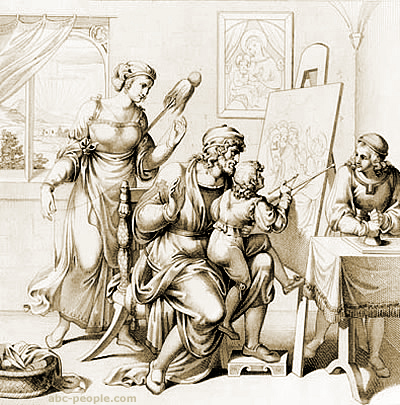 Franz and Christian von Hausen Riepe (Riepenhausen) From Raphael's childhood: on the lap of his father Giovanni Santi Engraving, 1816 |
Early years at Urbino Raphael was the son of Giovanni Santi and Magia di Battista Ciarla. His mother died in 1491. His father was, according to the 16th-century artist and biographer Giorgio Vasari, a painter "of no great merit." He was, however, a man of culture who was in constant contact with the advanced artistic ideas current at the court of Urbino. He gave his son his first instruction in painting, and, before his death in 1494, when Raphael was 11, he had introduced the boy to humanistic philosophy at the court. Urbino had become a centre of culture during the rule of Duke Federico da Montefeltro, who encouraged the arts and attracted the visits of men of outstanding talent, including Donato Bramante, Piero della Francesca, and Leon Battista Alberti, to his court. Although Raphael would be influenced by major artists in Florence and Rome, Urbino constituted the basis for all his subsequent learning. Furthermore, the cultural vitality of the city probably stimulated the exceptional precociousness of the young artist, who, even at the beginning of the 16th century, when he was scarcely 17 years old, already displayed an extraordinary talent. Giovanni Santi (c. 1435 – 1 August 1494) was an Italian painter, decorator, and the father of Raphael. He was born at Colbordolo in the Duchy of Urbino. He was a petty merchant for a time; he then studied under Piero della Francesca. He was influenced by Fiorenzo di Lorenzo, and seems to have been an assistant and friend of Melozzo da Forlì. He was court painter to the Duke of Urbino and painted several altarpieces, two now in the Berlin Museum, a Madonna in the church of San Francesco in Urbino, one at the church of Santa Croce in Fano, one in the National Gallery at London, and another in the gallery at Urbino; an Annunciation at the Brera in Milan; a resurrected Christ in the Museum of Fine Arts, Budapest; and a Jerome in the Lateran. He died in Urbino. |
Raphael
Sanzio: The date of Raphael's arrival in Perugia is not known, but several scholars place it in 1495. The first record of Raphael's activity as a painter is found there in a document of December 10, 1500, declaring that the young painter, by then called a "master," was commissioned to help paint an altarpiece to be completed by September 13, 1502. It is clear from this that Raphael had already given proof of his mastery, so much so that between 1501 and 1503 he received a rather important commission - to paint the Coronation of the Virgin for the Oddi Chapel in the church of San Francesco, Perugia (and now in the Vatican Museum, Rome). The
great Umbrian master Pietro Perugino was executing the frescoes
in the Collegio del Cambio at Perugia between 1498 and 1500, enabling
Raphael, as a member of his workshop, to acquire extensive professional
knowledge. |
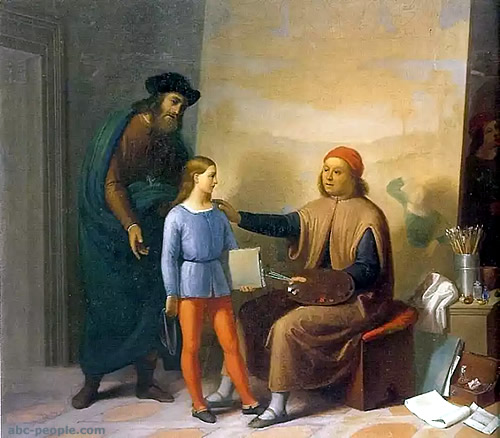 Raffaello led by Father Giovanni Santi to Perugia from Perugino |
Nevertheless, even in this early painting, it is clear that Raphael's sensibility was different from his teacher's. The disposition of the figures is less rigidly related to the architecture, and the disposition of each figure in relation to the others is more informal and animated. The sweetness of the figures and the gentle relation between them surpasses anything in Perugino's work. Three small paintings done by Raphael shortly after The Marriage of the Virgin - Vision of a Knight, Three Graces, and St. Michael - are masterful examples of narrative painting, showing, as well as youthful freshness, a maturing ability to control the elements of his own style. Although he had learned much from Perugino, Raphael by late 1504 needed other models to work from; it is clear that his desire for knowledge was driving him to look beyond Perugia.
|
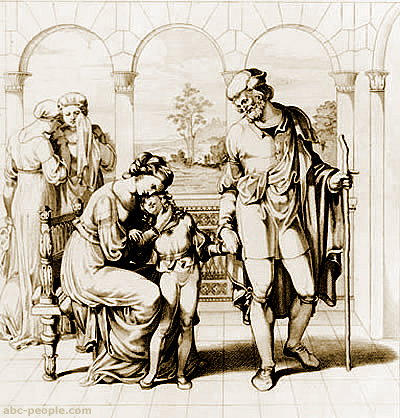 Franz and Christian von Hausen Riepe (Riepenhausen) Farewell Raphael by his mother to follow his father to Perugia Engraving, 1816 |
|
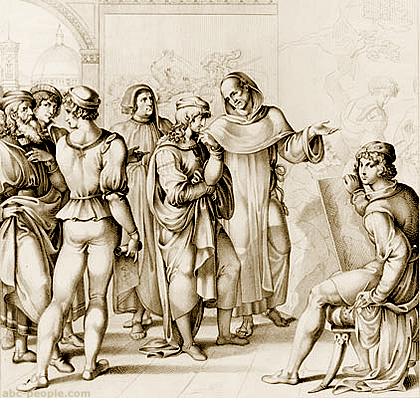 Franz and Christian von Hausen Riepe (Riepenhausen) Raphael in Florenz (At his side stands Fra Bartolomeo) Engraving, 1816 |
Move to Florence Vasari vaguely recounts that Raphael followed the Perugian painter Bernardino Pinturicchio to Siena and then went on to Florence, drawn there by accounts of the work that Leonardo da Vinci and Michelangelo were undertaking in that city. By the autumn of 1504 Raphael had certainly arrived in Florence. It is not known if this was his first visit to Florence, but, as his works attest, it was about 1504 that he first came into substantial contact with this artistic civilization, which reinforced all the ideas he had already acquired and also opened to him new and broader horizons. Vasari records that he studied not only the works of Leonardo, Michelangelo, and Fra Bartolomeo, who were the masters of the High Renaissance, but also "the old things of Masaccio," a pioneer of the naturalism that marked the departure of the early Renaissance from the Gothic. Still, his principal teachers in Florence were Leonardo and Michelangelo. Many of the works that Raphael executed in the years between 1505 and 1507, most notably a great series of Madonnas including The Madonna of the Goldfinch (1505; Uffizi Gallery, Florence), the Madonna del Prato (c. 1505; Kunsthistorisches Museum, Vienna), the Esterhazy Madonna (1505-1507; Museum of Fine Arts, Budapest), and La Belle Jardiniere (c. 1507; Louvre Museum, Paris), are marked by the influence of Leonardo, who since 1480 had been making great innovations in painting. |
Raphael was particularly influenced by Leonardo's Madonna and Child with St. Anne pictures, which are marked by an intimacy and simplicity of setting uncommon in 15th-century art. Raphael learned the Florentine method of building up his composition in depth with pyramidal figure masses; the figures are grouped as a single unit, but each retains its own individuality and shape. A new unity of composition and suppression of inessentials distinguishes the works he painted in Florence. Raphael also owed much to Leonardo's lighting techniques; he made moderate use of Leonardo's chiaroscuro (i.e., strong contrast between light and dark), and he was especially influenced by his sfumato (i.e., use of extremely fine, soft shading instead of line to delineate forms and features). Raphael went beyond Leonardo, however, in creating new figure types whose round, gentle faces reveal uncomplicated and typically human sentiments but raised to a sublime perfection and serenity. In 1507 Raphael was commissioned to paint the Deposition of Christ that is now in the Borghese Gallery in Rome. In this work, it is obvious that Raphael set himself deliberately to learn from Michelangelo the expressive possibilities of human anatomy. But Raphael differed from Leonardo and Michelangelo, who were both painters of dark intensity and excitement, in that he wished to develop a calmer and more extroverted style that would serve as a popular, universally accessible form of visual communication. |
| |
The decoration of the Stanza della Segnatura was perhaps Raphael's greatest work. Julius II was a highly cultured man who surrounded himself with the most illustrious personalities of the Renaissance. He entrusted Bramante with the construction of a new basilica of St. Peter to replace the original 4th-century church; he called upon Michelangelo to execute his tomb and compelled him against his will to decorate the ceiling of the Sistine Chapel; and, sensing the genius of Raphael, he committed into his hands the interpretation of the philosophical scheme of the frescoes in the Stanza della Segnatura. This theme was the historical justification of the power of the Roman Catholic church through Neoplatonic philosophy. The four main fresco walls in the Stanza della Segnatura are occupied by the Disputa and the School of Athens on the larger walls and the Parnassus and Cardinal Virtues on the smaller walls. The two most important of these frescoes are the Disputa and the School of Athens. The Disputa, showing a celestial vision of God and his prophets and apostles above a gathering of representatives, past and present, of the Roman Catholic church, equates through its iconography the triumph of the church and the triumph of truth. |
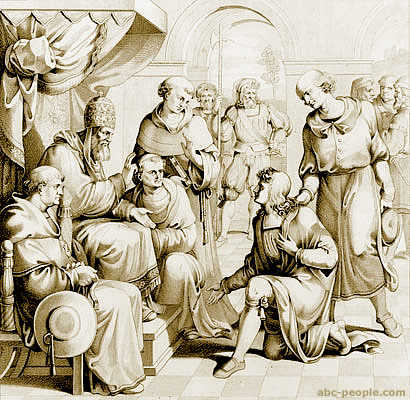 Franz and Christian von Hausen Riepe (Riepenhausen) Pope Julius II invite Raphael Engraving, 1816 |
|
The School of Athens is a complex allegory of secular knowledge, or philosophy, showing Plato and Aristotle surrounded by philosophers, past and present, in a splendid architectural setting; it illustrates the historical continuity of Platonic thought. The School of Athens is perhaps the most famous of all Raphael's frescoes, and one of the culminating artworks of the High Renaissance. Here Raphael fills an ordered and stable space with figures in a rich variety of poses and gestures, which he controls in order to make one group of figures lead to the next in an interweaving and interlocking pattern, bringing the eye to the central figures of Plato and Aristotle at the converging point of the perspectival space. The space in which the philosophers congregate is defined by the pilasters and barrel vaults of a great basilica that is based on Bramante's design for the new St Peter's in Rome. The general effect of the fresco is one of majestic calm, clarity, and equilibrium. About the same time, probably in 1511, Raphael painted a more secular subject, the Triumph of Galatea in the Villa Farnesina in Rome; this work was perhaps the High Renaissance's most successful evocation of the living spirit of classical antiquity. Meanwhile, Raphael's decoration of the papal apartments continued after the death of Julius in 1513 and into the succeeding pontificate of Leo X until 1517. In contrast to the generalized allegories in the Stanza della Segnatura, the decorations in the second room, the Stanza d'Eliodoro, portray specific miraculous events in the history of the Christian church. The four principal subjects are The Expulsion of Heliodorus from the Temple, The Miracle at Bolsena, The Liberation of St Peter, and Leo I Halting Attila. These frescoes are deeper and richer in colour than are those in the earlier room, and they display a new boldness on Raphael's part in both their dramatic subjects and their unusual effects of light. The Liberation of St Peter, for example, is a night scene and contains three separate lighting effects - moonlight, the torch carried by a soldier, and the supernatural light emanating from an angel. Raphael delegated his assistants to decorate the third room, the Stanze dell'Incendio, with the exception of one fresco, the Fire in the Borgo, in which his pursuit of more dramatic pictorial incidents and his continuing study of the male nude are plainly apparent. |
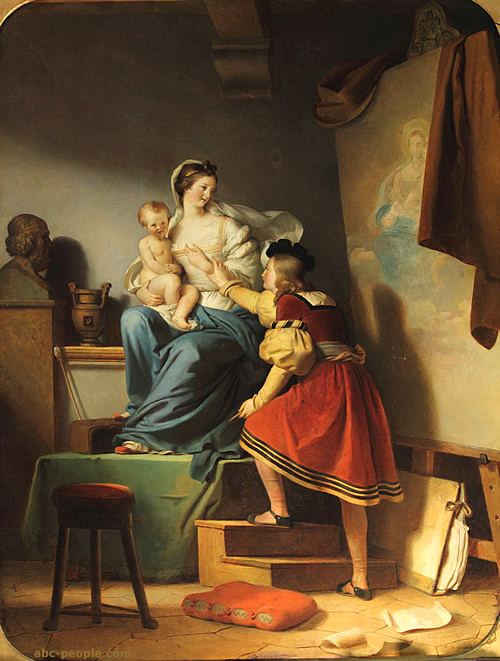 Fragonard, Alexandre Evariste (1780-1850) Raphael Adjusting his Model's Pose for his Painting of the Virgin and Child (oil on canvas) |
The Madonnas that Raphael painted in Rome show him turning away from the serenity and gentleness of his earlier works in order to emphasize qualities of energetic movement and grandeur. His Alba Madonna (1508; National Gallery, Washington) epitomizes the serene sweetness of the Florentine Madonnas but shows a new maturity of emotional expression and supreme technical sophistication in the poses of the figures. It was followed by the Madonna di Foligno (1510; Vatican Museum) and the Sistine Madonna (1513; Gemaldegalerie, Dresden), which show both the richness of colour and new boldness in compositional invention typical of Raphael's Roman period. Some of his other late Madonnas, such as the Madonna of Francis I (Louvre), are remarkable for their polished elegance. Besides his other accomplishments, Raphael became the most important portraitist in Rome during the first two decades of the 16th century. He introduced new types of presentation and new psychological situations for his sitters, as seen in the portrait of Leo X with Two Cardinals (1517-19; Uffizi, Florence). Raphael's finest work in the genre is perhaps the Portrait of Baldassare Castiglione (1516; Louvre), a brilliant and arresting character study. Leo X commissioned Raphael to design 10 large tapestries to hang on the walls of the Sistine Chapel. Seven of the ten cartoons (full-size preparatory drawings) were completed by 1516, and the tapestries woven after them were hung in place in the chapel by 1519. The tapestries themselves are still in the Vatican, while seven of Raphael's original cartoons are in the British royal collection and are on view at the Victoria and Albert Museum in London. These cartoons represent Christ's Charge to Peter, The Miraculous Draught of Fishes, The Death of Ananias, The Healing of the Lame Man, The Blinding of Elymas, The Sacrifice at Lystra, and St Paul Preaching at Athens. In these pictures Raphael created prototypes that would influence the European tradition of narrative history painting for centuries to come. The cartoons display Raphael's keen sense of drama, his use of gestures and facial expressions to portray emotion, and his incorporation of credible physical settings from both the natural world and that of ancient Roman architecture. |
| While he was at work in the Stanza della Segnatura, Raphael also did his first architectural work, designing the church of Sant' Eligio degli Orefici. In 1513 the banker Agostino Chigi, whose Villa Farnesina Raphael had already decorated, commissioned him to design and decorate his funerary chapel in the church of Santa Maria del Popolo. In 1514 Leo X chose him to work on the basilica of St Peter's alongside Bramante; and when Bramante died later that year, Raphael assumed the direction of the work, transforming the plans of the church from a Greek, or radial, to a Latin, or longitudinal, design. Raphael was also a keen student of archaeology and of ancient Greco-Roman sculpture, echoes of which are apparent in his paintings of the human figure during the Roman period. In 1515 Leo X put him in charge of the supervision of the preservation of marbles bearing valuable Latin inscriptions; two years later he was appointed commissioner of antiquities for the city, and he drew up an archaeological map of Rome. Raphael had by this time been put in charge of virtually all of the papacy's various artistic projects in Rome, involving architecture, paintings and decoration, and the preservation of antiquities. Raphael's last masterpiece is the Transfiguration (commissioned in 1517), an enormous altarpiece that was unfinished at his death and completed by his assistant Giulio Romano. It now hangs in the Vatican Museum. The Transfiguration is a complex work that combines extreme formal polish and elegance of execution with an atmosphere of tension and violence communicated by the agitated gestures of closely crowded groups of figures. It shows a new sensibility that is like the prevision of a new world, turbulent and dynamic; in its feeling and composition it inaugurated the Mannerist movement and tends toward an expression that may even be called Baroque. Raphael
died on his 37th birthday. His funeral mass was celebrated at the
Vatican, his Transfiguration was placed at the head of the bier,
and his body was buried in the Pantheon in Rome. |
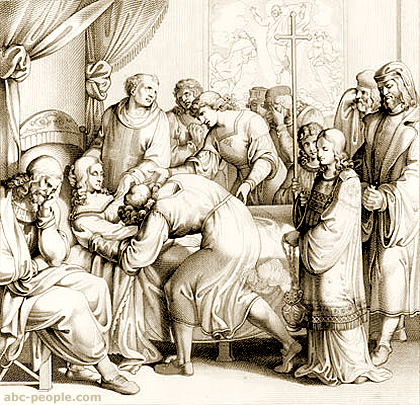
Franz and Christian von Hausen Riepe (Riepenhausen) Raphael's death Engraving, 1816 |
Raphael's death and Funeral According to Vasari, Raphael's premature death on Good Friday (April 6, 1520), which was possibly his 37th birthday, was caused by a night of excessive sex with Luti, after which he fell into a fever and, not telling his doctors that this was its cause, was given the wrong cure, which killed him. Vasari also says that Raphael had also been born on a Good Friday, which in 1483 fell on March 28. Whatever the cause, in his acute illness, which lasted fifteen days, Raphael was composed enough to receive the last rites, and to put his affairs in order. He dictated his will, in which he left sufficient funds for his mistress's care, entrusted to his loyal servant Baviera, and left most of his studio contents to Giulio Romano and Penni. At his request, Raphael was buried in the Pantheon. His
funeral was extremely grand, attended by large crowds. The inscription
in his marble sarcophagus, an elegiac distich written by Pietro
Bembo (1470-1547),
|
||||
|
|||||
| Where is Raphael buried? In
his will, Raphael expressed his wish to be buried in the Pantheon,
one of his favorite classical buildings, and left 1,500 ducats for
its interior restoration. He
requested that his tomb be placed beneath an altar and below a statue
of the Virgin Mary. |
 |
Ippolito
Caffi Belluno Pantheon (detailed) c. 1840 |
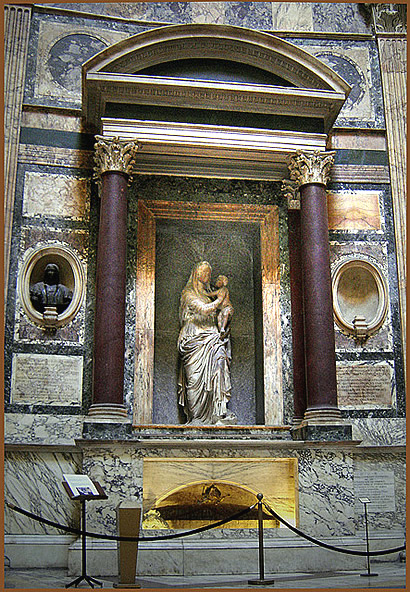 Raphael and Maria Bibbiena's tomb in the Pantheon The Madonna is by Lorenzetto. |
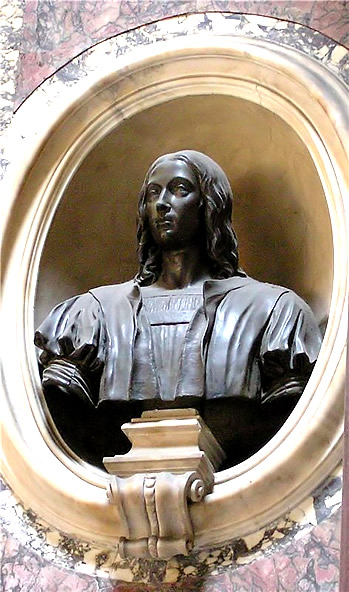 Bronze bust of Raphael on top of the artist's tomb at the Pantheon in Rome by Giuseppe de Fabris, 1833 |
|||
|
The
inscription in his marble sarcophagus, an elegiac distich written
by Pietro Bembo, reads: |
||||
|
||||
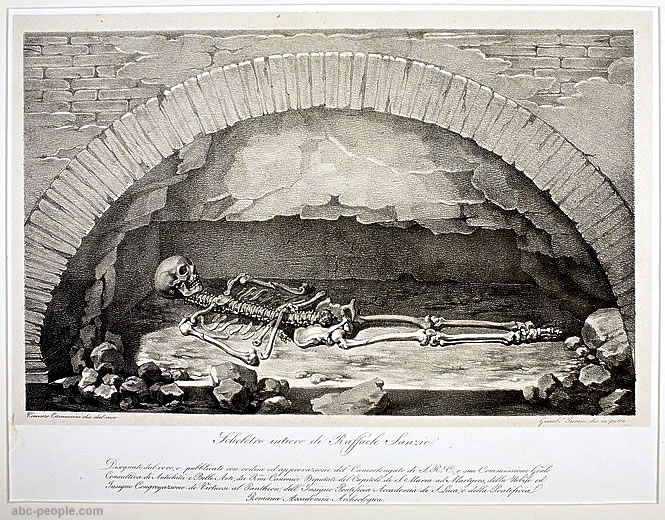 Giambattista Borani After drawing by Vincenzo Camuccini Raphael's Skeleton at the Opening of his Tomb c. 1833, Lithograph. 380 x 505 mm |
||||
|
||||
Perpetuate
the memory of Raphael |
|
|
|
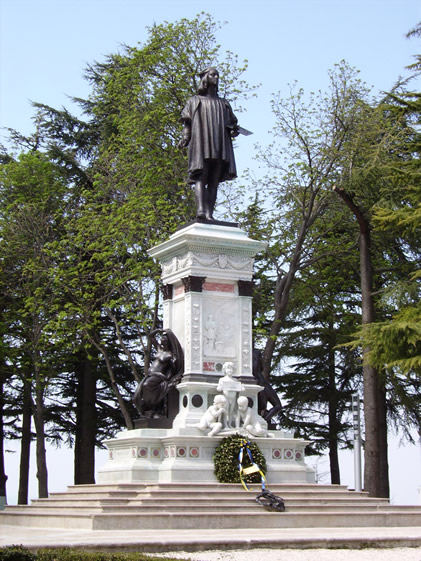 Monument to Raffaello Sanzio Urbino |
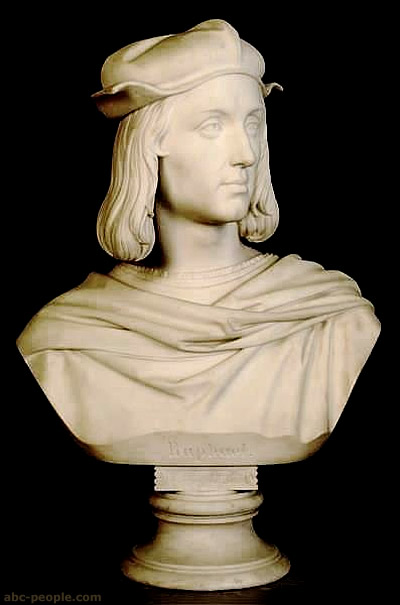 Raphael Marble Bust by Ernst Julius Hähnel, 1875 |
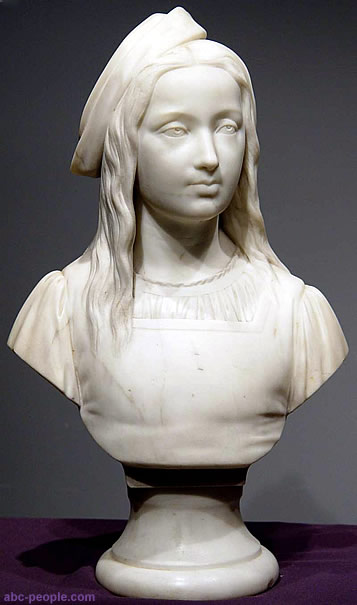 Charles Rochet (French 1819-1900) "Raphael Enfant" (Raphael as a child) A Carrara marble sculpture signed and inscribed "Raphael Enfant" dated 1880 |
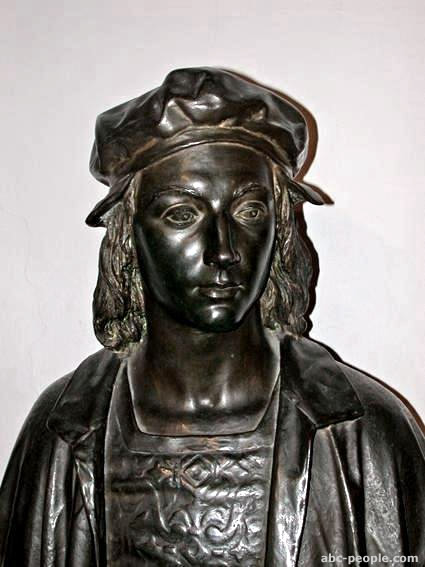 Raphael Sanzio Sculpture |
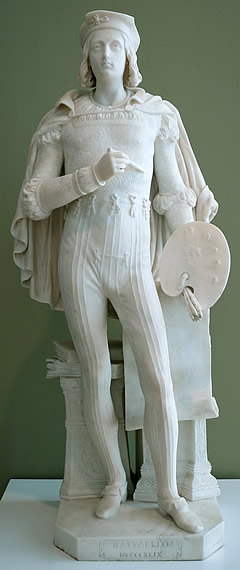 Raphael by Thomas Crawford, marble, 1855, High Museum |
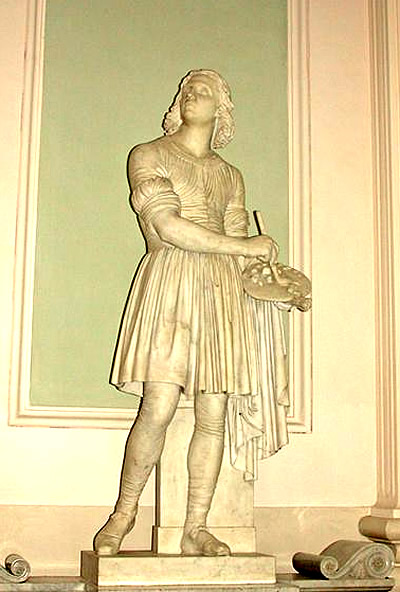 Raphael Sanzio by Carlo Finelli, 1847 |
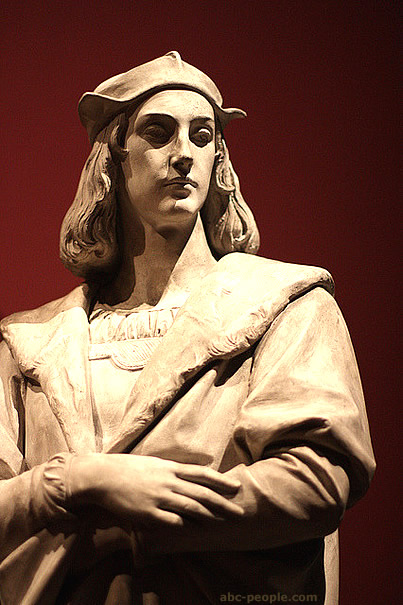 Raphael Sculpture by Ernst Julius Hähnel, c. 1852-69 |
|
|
| Copyright
© 2004 abc-people.com Design and conception BeStudio © 2014-2023 |
